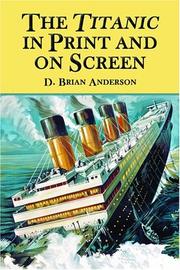| Listing 1 - 10 of 18 | << page >> |
Sort by
|
Book
ISBN: 1603061169 9781603061162 9781588382825 1588382826 Year: 2012 Publisher: Montgomery, AL NewSouth Books
Abstract | Keywords | Export | Availability | Bookmark
 Loading...
Loading...Choose an application
- Reference Manager
- EndNote
- RefWorks (Direct export to RefWorks)
Book
ISBN: 1283873753 1845646797 9781845646790 9781845646783 1845646789 9781283873758 Year: 2013 Publisher: Southampton, UK WIT Press
Abstract | Keywords | Export | Availability | Bookmark
 Loading...
Loading...Choose an application
- Reference Manager
- EndNote
- RefWorks (Direct export to RefWorks)
The main character in the book wrote to his friend: ""Josey, I'm embarking on the biggest steamship in the world, but I don't feel any pride, because at this moment I wish the `Titanic' were submerged at the bottom of the sea..."" In his ""A Suitcase from the Titanic"" author Enrique Dick takes us into a whirlwind of family history, Samuel and Annie Andrew arrive from Whitby, Yorkshire, England, to the vast pampas of Argentina, near the end of the nineteenth century.
Titanic (Steamship) --- Argentina --- History.
Book
ISBN: 153615041X 9781536150414 1536150401 9781536150407 Year: 2019 Publisher: New York
Abstract | Keywords | Export | Availability | Bookmark
 Loading...
Loading...Choose an application
- Reference Manager
- EndNote
- RefWorks (Direct export to RefWorks)
Book
ISBN: 0973893419 1786944634 1786949032 9781786949035 9780973893410 Year: 2006 Volume: 31 Publisher: St. John's, Nfld.
Abstract | Keywords | Export | Availability | Bookmark
 Loading...
Loading...Choose an application
- Reference Manager
- EndNote
- RefWorks (Direct export to RefWorks)
This work seeks to understand why a disproportionately large number of third class passengers, particularly women and children, died during the sinking of the Titanic in relation to the first and second classes. It examines the gender, class, social, and cultural factors that influenced this disparity. It aims to uncover both why and how five hundred and thirty one third class passengers died on the night of April 14th 1912. A key area of focus is the difficult relationship between the ship's authorities and the men of the third class, and the extent to which this determined the fate of passengers during the rescue efforts. The introduction asks 'Who were the third class passengers?' and uses ethnic and economic backgrounds to suggest the third class belonged to the 'Old Immigration' wave of migrants, rather than the contemporary 'New Immigration' of the first and second. The first chapter concerns the exclusion of third class narratives in the 'popular story' of the Titanic. Chapters two through seven determine the whereabouts of the third class during every stage of evacuation, and flags the discrepancies in testimonies from both the British and American inquiries. Chapter eight provides a conclusion, which claims the 'popular story' includes a great many falsehoods with regard to the third class - including their treatment by crew, their behaviours, and their survival rates. The first appendix tables nationalities into regions; the second outlines the twenty routes to the lifeboats, as testified by one of the Titanic design architects; and the third provides deck plans for every level of the ship.
Shipwrecks --- Titanic (Steamship) --- History. --- R.M.S. Titanic --- RMS Tʻaitʻanik --- RMS Titanic --- RMS 타이타닉 --- Tʻaitʻanik (Steamship) --- Taytānīk (Steamship) --- Titanik (Steamship) --- Титаник (Steamship) --- טיטאניק (Steamship) --- טיטניק (Steamship) --- تيتانيك (Steamship) --- 타이타닉 (Steamship)
Book
ISBN: 1283639378 1442218924 9781442218925 1442218908 9781283639378 9781442218901 Year: 2012 Publisher: Lanham, MD : Rowman & Littlefield Publishers, Inc.,
Abstract | Keywords | Export | Availability | Bookmark
 Loading...
Loading...Choose an application
- Reference Manager
- EndNote
- RefWorks (Direct export to RefWorks)
In The Titanic Revisited John Lang brings his expertise as a naval investigator to reexamine the sinking of the Titanic on her maiden voyage in April 1912, which became one of the defining moments of the twentieth century.
Shipwrecks --- Titanic (Steamship) --- RMS Titanic --- R.M.S. Titanic --- Титаник (Steamship) --- تيتانيك (Steamship) --- Titanik (Steamship) --- Taytānīk (Steamship) --- טיטניק (Steamship) --- RMS 타이타닉 --- RMS Tʻaitʻanik --- 타이타닉 (Steamship) --- Tʻaitʻanik (Steamship) --- טיטאניק (Steamship) --- Geschichte 1912. --- North Atlantic Ocean. --- Atlantic Ocean --- History.

ISBN: 1476606471 9781476606477 0786417862 9780786417865 Year: 2005 Publisher: Jefferson, N.C.
Abstract | Keywords | Export | Availability | Bookmark
 Loading...
Loading...Choose an application
- Reference Manager
- EndNote
- RefWorks (Direct export to RefWorks)
Titanic scholars contend that the demise of ""the unsinkable ship"" left more behind than a memory of April 15, 1912, as an important point in history. Through books, films, stories, and songs, the archetypal shipwreck has endured as a metaphor for the perils of mankind's hubris and the fallibility of technology. In 1985, the discovery of the long-missing wreckage two miles below the surface of the Atlantic revitalized interest in the Titanic and spawned a new generation of books, films, and, for the first time, websites, and computer games. James Cameron's blockbuster Titanic became the bigge
Shipwrecks --- Marine disasters --- Wrecks --- Adventure and adventurers --- Marine accidents --- Voyages and travels --- Collisions at sea --- Titanic (Steamship) --- RMS Titanic --- R.M.S. Titanic --- Титаник (Steamship) --- تيتانيك (Steamship) --- Titanik (Steamship) --- Taytānīk (Steamship) --- טיטניק (Steamship) --- RMS 타이타닉 --- RMS Tʻaitʻanik --- 타이타닉 (Steamship) --- Tʻaitʻanik (Steamship) --- טיטאניק (Steamship) --- In mass media
Book
ISBN: 0300224249 9780300224245 9780300221381 030022138X Year: 2016 Publisher: New Haven
Abstract | Keywords | Export | Availability | Bookmark
 Loading...
Loading...Choose an application
- Reference Manager
- EndNote
- RefWorks (Direct export to RefWorks)
A fascinating reassessment of a turning point in the First World War, revealing its role in shaping the German psyche On May 7, 1915, the Lusitania, a large British luxury liner, was sunk by a German submarine off the Irish coast. Nearly 1,200 people, including 128 American citizens, lost their lives. The sinking of a civilian passenger vessel without warning was a scandal of international scale and helped precipitate the United States’ decision to enter the conflict. It also led to the immediate vilification of Germany. Though the ship’s sinking has preoccupied historians and the general public for over a century, until now the German side of the story has been largely untold. Drawing on varied German sources, historian Willi Jasper provides a comprehensive reappraisal of the sinking and its aftermath that focuses on the German reaction and psyche. The attack on the Lusitania, he argues, was not simply an escalation of violence but signaled a new ideological, moral, and religious dimension in the struggle between German Kultur and Western civilization.
World War, 1914-1918 --- Naval operations --- Submarine. --- Moral and ethical aspects. --- Lusitania (Steamship) --- R.M.S. Lusitania (Steamship) --- RMS Lusitania (Steamship) --- Shipwrecks --- Naval operations, German --- History

ISBN: 9023006925 Year: 1991 Publisher: Haarlem Becht
Abstract | Keywords | Export | Availability | Bookmark
 Loading...
Loading...Choose an application
- Reference Manager
- EndNote
- RefWorks (Direct export to RefWorks)
History of the Netherlands --- Shipbuilding industry --- Employees --- Medical care --- Amsterdam (Steamship) --- Nederlandsche Oost-Indische Compagnie --- History.
Book
ISBN: 1476632634 9781476632636 9781476674100 1476674108 Year: 2018 Publisher: Jefferson, North Carolina
Abstract | Keywords | Export | Availability | Bookmark
 Loading...
Loading...Choose an application
- Reference Manager
- EndNote
- RefWorks (Direct export to RefWorks)
"On December 22, 1853, the San Francisco left New York, chartered by the U.S. Government to transport the Third Artillery. Two days out, the ship ran into one of the great hurricanes of maritime history. A few days later, cholera broke out. After two weeks, survivors were rescued by three ships but barely made it back"--
Shipwrecks --- Voyages to the Pacific coast. --- Steamboat disasters --- History --- San Francisco (Steamship)
Book
ISBN: 1788123867 9781788123860 9781910248270 1910248274 Year: 2016 Publisher: Dublin
Abstract | Keywords | Export | Availability | Bookmark
 Loading...
Loading...Choose an application
- Reference Manager
- EndNote
- RefWorks (Direct export to RefWorks)
"Thanks to the gift of a ticket from his uncle, a young Jesuit named Francis Browne traveled on the Titanic during her maiden voyage from Southampton, to Cherbourg to Cork. A keen photographer, Fr Browne took many unique photographs of the ship and her passengers. Invited to remain with the ship as it crossed the Atlantic, Fr Browne was saved from possible disaster by a telegram from his Jesuit superior ordering him to "get off that ship". When the unthinkable happened and the Titanic sank, Fr Browne's photographs appeared on the front pages of newspapers all around the world. For many years the photographs of Fr Browne were forgotten until 1985 when Fr Eddie O'Donnell happened across an old tin trunk in the Jesuit archives and re-discovered 42,000 photographs, including the Titanic collection. The book includes many extracts from Fr Browne's personal Titanic album."--Amazon.com.
Navigation --- History. --- Browne, Frank, --- Photograph collections. --- Titanic (Steamship) --- White Star Line
| Listing 1 - 10 of 18 | << page >> |
Sort by
|

 Search
Search Feedback
Feedback About UniCat
About UniCat  Help
Help News
News